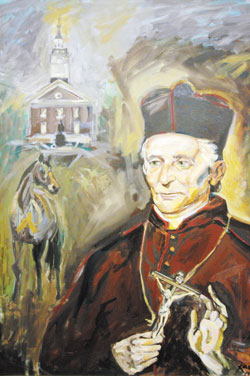Prayer helps artist create portrait of Bishop Bruté

Our Lady of the Most Holy Rosary parishioner Kara Halla of Westfield, Ind., recently painted this portrait of the Servant of God Simon Bruté as a commissioned gift for Archbishop Daniel M. Buechlein. The painting will be hung in the parlor at the Cathedral Parish rectory in Indianapolis. (Photo by Mary Ann Wyand)
By Mary Ann Wyand
Colorful brush strokes bring the dramatic oil painting of the Servant of God Simon Bruté to life.
Artist Kara Halla prayed to God and Mary as well as to Bishop Simon Guillaume Gabriel Bruté de Rémur—who was named the first bishop of the newly created Diocese of Vincennes in 1834—while she painted the French priest’s portrait in December.
With divine help, Halla said, she was able to complete the painting of the bishop—which is 3 feet wide and 4 feet high—in about 18 hours by using a preliminary sketch that she drew in June as a guide.
“I read a little bit about his life and prayed to Bishop Bruté to help me to make him [look] the way he should be,” she said. “I had all my holy cards and my crucifix with me, and I prayed the rosary.”
In her painting, Bishop Bruté is shown holding a crucifix with the Old Cathedral in Vincennes at the top left. A horse symbolizes his missionary travels during the early years of the diocese. At the time, the diocese included all of Indiana and the eastern portion of Illinois.
The painting was commissioned by Servants of the Gospel of Life Sister Diane Carollo, director of the archdiocesan Office for Pro-Life Ministry, as an anniversary gift for Archbishop Daniel M. Buechlein to commemorate his 15 years as Archbishop of Indianapolis and 20 years as a bishop.
The Missionary Servants of the Gospel of Life, a lay order dedicated to pro-life ministry in the archdiocese, and archdiocesan Birthline volunteers also helped sponsor Halla’s artistic endeavor.
Sister Diane gave the painting to Archbishop Buechlein on Dec. 19 at the Archbishop O’Meara Catholic Center. It will be hung in the parlor at the Cathedral Parish rectory.
“In gratitude for his 15 years as our faithful shepherd,” Sister Diane explained, “I asked Kara Halla, a very talented local artist, to paint a portrait of Bishop Bruté for Archbishop Buechlein.
“Through Bishop Bruté’s life of extraordinary sacrifice, charity and missionary zeal, the Church in Indiana began its historical roots,” Sister Diane said. “Bishop Bruté’s life of humble and generous service continues to serve as a model for all of us today.”
Archbishop Buechlein expressed his appreciation for the unique and historical gift in a “thank you” note to Sister Diane.
“The portrait of Bishop Bruté is splendid,” the archbishop wrote, offering his congratulations to the artist.
“My warmest thanks to you,” he added to Sister Diane. “Please extend the same to the generous donors.”
Bishop Bruté was born in Rennes, France, on March 20, 1779. He came to Indiana with only two priests and served as bishop of the Diocese of Vincennes from 1834 until his death in 1839. In only five years, he earned a reputation as a holy priest and hard-working bishop.
The Diocese of Vincennes—now the Archdiocese of Indianapolis—was created by Pope Gregory XVI on May 6, 1834.
In the fall of 2005, Archbishop Buechlein officially opened the cause of canonization for Bishop Bruté, who is now rightly called a “Servant of God.”
Kara (Coleman) Halla grew up in Our Lady of Mt. Carmel Parish in Carmel, Ind., graduated from Carmel High School and attended the Art Institute of Chicago.
Halla lives in Westfield, Ind., with her husband, Jason, and 8-year-old son, Liam, who is a fledgling artist.
They attend the traditional Latin Mass at Our Lady of the Most Holy Rosary Parish in Indianapolis, where Sister Diane serves as director of religious education.
Halla, who also volunteers for the archdiocesan Birthline pro-life telephone ministry, said she enjoys creating religious artwork and would like to paint a portrait of St. Theodora Guérin, foundress of the Sisters of Providence of Saint Mary-of-the-Woods.
“When we went there last year on the day before her canonization, we were able to see her relics,” Halla said. “To be able to experience that was amazing.” †
